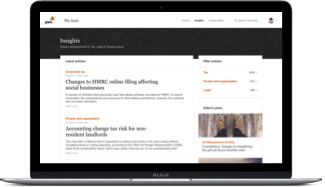On 22 January HMRC issued long awaited draft regulations for technical consultation which will allow unpaid PAYE debts under the forthcoming IR35 reforms (to be implemented from 6 April 2020) to be recovered from other "relevant persons" further up the supply chain. Broadly equivalent draft regulations have also been published with respect to NIC debts.
We have been pressing for sight of these draft regulations for several months now, and so whilst their publication is welcome, the timing is arguably somewhat unfortunate, given it comes in the midst of the Government's current implementation review on the IR35 reforms. Interpreting the full scope/significance of the provisions is also made more difficult as the revised draft of the main primary tax legislation, which will implement the IR35 reforms, has not yet been published.
When these debt recovery powers were previously mooted, HMRC explained that the proposals were not intended to "transfer liabilities in cases of genuine business failure, where deliberate tax avoidance has not occurred". However, on first reading, businesses are likely to be disappointed that this intention has not been given statutory force by the Government, and instead HMRC are likely to be provided with wide ranging recovery powers in the regulations. This is tempered only by a comment within the accompanying technical note, that HMRC will not "exercise" these powers in cases of "genuine business failure". It is hoped, at least, that forthcoming HMRC guidance will set out in more detail the circumstances in which it will not seek unpaid liabilities from parties further up the supply chain.
The draft legislation enables HMRC to issue a recovery notice to recover the PAYE debt from other relevant persons such as onshore agencies/MSPs further up the supply chain or the end user "client" where HMRC "considers that there is no realistic prospect of recovery of a relevant PAYE debt within a reasonable period of time" (our emphasis). The regulations also contain an order of priority in pursuing the debt, so HMRC must pursue an onshore MSP/agency higher up the supply chain first before they can pursue the client.
The meaning of "realistic prospect" and "reasonable period of time" are likely to be hotly debated over the coming weeks and months as these are the key conditions for the recovery notice to be issued and key grounds on which an appeal can be made. Without any clear definitions in legislation, the concern would be that it is left for the courts to interpret their meaning, adding more uncertainty for business.
Another concern is likely to be the lengthy time period that HMRC have to issue a recovery notice. Whilst in principle, HMRC have a two year period to do this, the starting point for the two year period is flexible, beginning with:
- 30 days following the date the PAYE determination became "final and conclusive"; or
- when HMRC becomes aware that it has "sufficient information" to make such a determination/notice of decision but that it would be "impractical" to do so on account of the liquidation, dissolution or other incapacity" of the deemed employer.
This again raises further questions. When does an assessment become "final and conclusive"? Is it before or after the window for appeal against the assessment? If an appeal is made, does the assessment not become final and conclusive until the appeal has worked its way through the tribunals? If so, how long could the threat of debt transfer hover over clients.
Where an assessment isn't raised, what constitutes "impractical" - particularly in light of HMRC's proposals to become a preferred creditor for PAYE and employees' NIC debt from April 2020 - and when is there "sufficient information".
For end user clients, one practical response to these regulations may be to shift buying behaviour towards onshore MSPs/agencies who may have longer trading histories, deeper pockets and more comprehensive insurance. This would arguably be an unfortunate but perhaps inevitable policy outcome, reducing dynamism in a market where there had previously been limited barriers to entry and frequent new entrants.
Whilst it is hoped that further clarity may be provided on the operation of these rules (ideally through amendments to legislation but if not through guidance), these measures can be seen in the context of a longer term trend from tax authorities to encourage clients to secure their supply chain.
With limited time remaining until the IR35 reforms take effect, businesses are encouraged to engage with the technical consultation, whilst simultaneously reviewing their supplier relationships to ensure that they have considered whether they are the "client" (under the IR35 legislation) in any services from a vendor which involves labour and, where appropriate, have considered how the risks of PAYE and NIC debt transfer provisions can be managed.

